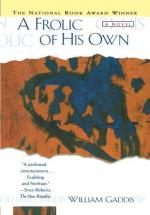|
This section contains 613 words (approx. 2 pages at 400 words per page) |

|
A Frolic of His Own Summary & Study Guide Description
A Frolic of His Own Summary & Study Guide includes comprehensive information and analysis to help you understand the book. This study guide contains the following sections:
This detailed literature summary also contains Topics for Discussion and a Free Quiz on A Frolic of His Own by William Gaddis.
A Frolic of His Own follows the legal entanglements of a plagiarized playwright, Oscar Crease, along with his quirky federal judge father, hapless girlfriend, Lily, controlling stepsister, Christina, overworked but affable corporate lawyer, brother-in-law, Harry, and assorted advocates, agents, artists and clergymen who are all looking out for their own best interests.
Oscar Crease is an independently wealthy college history teacher, who craves recognition. He discovers that the play he wrote over a decade ago, Once at Antietam, which was rejected for television, has been lifted to serve as the basis for a blockbuster Hollywood movie, The Blood in the Red, White and Blue. Reviews emphasize bad acting, spectacular battle scenes and sex. Oscar is affronted and determined to sue. He is also ready to sue his insurance company, rather than accept a No Fault settlement, after being run over by his own car. He's hospitalized and confined to a wheelchair, alone in his broken down, Long Island home.
Oscar's girlfriend, Lily, is perennially broke and struggling with attorneys to complete her divorce. She and Oscar's stepsister, Christina, and brother-in-law, Harry Lutz, a high-power corporate lawyer, drop in frequently. Lily's lawyer, Kevin, offers to handle Oscar's personal injury suit on a contingency basis. Harry cannot take on Oscar's plagiarism case, but puts him in touch with an old law school friend, and regularly cautions Oscar about the risk and cost of litigation. Harry is less successful in evading professional involvement with Christina's litigious socialite friend, Trish Hemsley.
At the same time, Oscar's father, federal Judge Thomas L. Crease, son of the late Supreme Court Justice Thomas Crease, the inspiration for Oscar's play, is under attack in the media for his decisions and offhand remarks in a series of lawsuits over an outdoor monumental sculpture, Cyclone Seven, and the economically struggling Tatamount, VA. A mongrel dog, Spot, gets trapped in the sculpture, gains national fame for his plight, and is subsequently killed by lightening. Lawsuits multiply and political enemies try to block Crease's nomination to a higher court and/or secure his impeachment.
Harold Basie, a black man and associate, is assigned to weigh the merits of Oscar's case, and while he finds it weak, agrees to see the movie before deciding. Evidence emerges as it's discovered that the film's producer, Konstantine Kiester, is the same producer who earlier rejected Oscar's play. He had simply changed his name to Jonathan Livingston (Siegal). Basie decides to move forward with the suit. Oscar is deposed by a Hindu associate in Harry's firm, Jawaharlal Mahdar Pai, who successfully argues the movie is based on materials in the public domain. Basie is discovered to be an ex-con and fraudulent lawyer. Oscar's domineering father, from whom he is largely estranged, is enraged by the verdict and anonymously writes an appeal that prevails. Oscar is awarded the film's immense profits, as damages. Pai gets Oscar's reward reduced to the original out-of-court settlement after learning Oscar has found a producer to stage the play. Pai becomes romantically involved with his scofflaw client, Trish.
Lily's father cuts her out of his will on advice from his greedy spiritual guide, Rev. Bobby Joe. At the same time, she learns that the lump in her breast about which she has long obsessed, is leakage from implants rather than cancer. Oscar's father and overworked Harry both die, each as he realizes a major victory. Crease leaves an estate too small for Oscar to pay his legal bills, and the firm collects Harry's life insurance. Oscar settles the personal injury suit, but ends depressed, discovering the chronology of his family myth on which he based his play is off by one generation.
Read more from the Study Guide
|
This section contains 613 words (approx. 2 pages at 400 words per page) |

|



